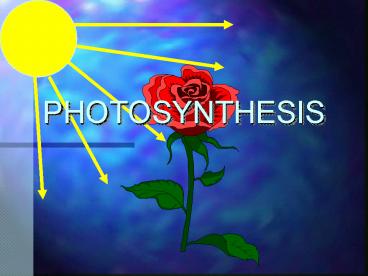PHOTOSYNTHESIS PowerPoint PPT Presentation
1 / 26
Title: PHOTOSYNTHESIS
1
PHOTOSYNTHESIS
2
Photosynthesis
Light Making
- The source of all life energy?
- Performed by Green Plants
- E 6CO2 6H2O C6 H12O6 6O2
3
I. Structure of chloroplasts
- A. Diagram
Grana
Reservoir
Inner and Outer membranes
Thylakoid membranes
Stroma
4
TEM View
5
B. Thylakoid membranes have
- Embedded chlorophyll and other pigments
- Molecules of the electron transport chain
- Protein complexes to make ATP
6
C. Stroma
- Has enzymes that join carbons together to form
carbohydrates
7
II. Trapping light energy
- A. Photosynthetic pigments
- Absorb light
- Why are plants green?
- Because they absorb red and blue
8
Visible light
9
Pigment absorbtion
10
B. Chlorophylls - main pigments
- Several types
- e.g. chlorophylls a, b, c, d
- Excite electrons
11
C. Accessory Pigments
- a. Capture light of various wavelengths other
than those collected by chlorophylls - b. Example carotenoids
- Yellow and red leaves in the fall
- Carrots?
12
1. Carotenoids
- Also detoxify peroxy radicals that could destroy
chlorophyll
13
D. Photosystems
- Groups of pigments that capture light
- Two types
- 1. Photosystem 1
- Absorbs light of an average of 700 nM and so is
called P700 - 2. Photosystem 2
- Absorbs and average of 680nM (P680)
14
(No Transcript)
15
III. What happens in photosynthesis, an overview
- A. Light absorption
- B. Electron transport chain
- C. Chemiosmosis
- D. Carbon fixation
16
IV Light Absorption and electron flow
- A. Happens in the thylakoids
- B. Cyclic and noncyclic electron flow
17
(No Transcript)
18
C. Chemiosmotic ATP synthesis
19
V. Carbon fixation
- Diagram
20
VI. Rate of photosynthesis
- Controlled by
- A. Amount of light
- B. Heat
- C. Transport of H2O, CO2, O2
- Photorespiration?
21
VII. Ecological aspects of photosynthesis
- Plants in different ecosystems have different
needs - A. C4 method of carbon fixation
- Hatch Slack pathway
- Used by bermuda grass, bamboo, and other tropical
plants
22
C3 and C4 leaves
23
C4 path continued
- 1. Used by tropical plants.
- Conditions?
- Much light , warm, humid
- 2. Light is absorbed by one cell and carbon
fixation happens in another - 3. Avoids photorespiration
- 4. Fast but somewhat inefficient. Plants grow
rapidly
24
B. Crassulacean acid metabolism (CAM)
- 1. Used by desert succulents
- 2. Conditions
- Hot, dry, very intense light
- 3. These plants close stomata during the day to
conserve water - 4. At night, stomata open and CO2 is stored in
organic acids - 5. During the day CO2 is removed from acid and
used in C3 cycle
25
C. Sun plants and shade plants
- 1. Sun plants are designed for full sun
- Have thick, lobed leaves
- More pallisade mesophyll
- More stomata
- More RuBP carboxylase
- 2. Shade plants designed for low light
- Thinner leaves
- Fewer photosynthetic cells, more chlorophyll
- Slow photosynthesis in all light conditions
26
- 3. Some trees have both sun leaves and shade
leaves on the same plant - e.g. oak trees

